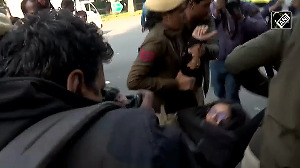Like Delhi, Hyderabad and Bangalore, Mumbai is trying to introduce modern air-conditioned metered taxis on its roads. Unlike the other cities, however, Mumbai has had cabs plying its roads for over a century and there are already about 51,000 black and yellow cabs on the city's roads.
Delhi, which also recently launched new taxis, has far fewer taxis on its roads (just 3,000 by one account); while in Hyderabad, Bangalore and Chennai privately-run 'tourist' taxis rather than metered cabs dominate.
In Delhi, a few new operators have been permitted to operate up to 500 taxis for which no individual taxi permits are required. In contrast, Mumbai's cabs have individual permits.
And when taxi operators launched their service last year, the state government decided that no new permits would be issued to them because there is no room to put more cabs on the city's roads unless some of the old ones are pulled out.
In fact, no new taxi permits have been issued in Mumbai for a decade because the authorities reckoned that an adequate number has been provided to serve the city's needs.
Instead, the new operator must negotiate with each permit-owner to acquire his license. More than a year after the new scheme was launched, with two new taxi operators in business and a third service for women launched recently, there are fewer than 500 new cabs on Mumbai's roads.
There are several reasons why the scheme is not working. The permits or licences may not be transferred to anyone apart from the immediate family of the owner. Under the new scheme, the operator would have to persuade an owner to lease his permit to the company for a sum of money and offer him the option but not the obligation to become an employee.
As an employee, he gets to use a new vehicle (after surrendering his old one) for a fixed daily rental (a subscription fee) and to keep what he earns after having paid for the fuel.
The company also offers to train him, pays for the repair and service costs of the taxis and offers the driver some benefits in the form of provident fund and a medical insurance cover.
Taxi unions have resisted the change, fearing that the new scheme would, as it indeed does, take away the cab-owners' control of the trade by turning them from self-employed persons into company employees.
Most owners run their taxis on two shifts by hiring out their taxis to drivers, while, as employees, they must work a single 12-hour shift; others may have mortgaged their vehicles to banks to raise personal loans and must pay off those loans.
Also, the older cab-drivers are generally unwilling to adjust to a new life governed by rules. As employees, they must keep fixed hours on the road (all GPS-monitored) and follow rules; as a call taxi service, they may not refuse anyone a ride.
The taxi operators say that although the demand for the new cabs is growing, they are unable to acquire enough permits to put more taxis on the roads. Running the business on the basis of leased permits has too many risks. The operator cannot be certain about the terms on which the lease will be renewed, if at all.
At present, the price of a five-year lease is around Rs 60,000 but that could rise or fall as more taxi-owners join the scheme or the demand for the new taxis rises.
The government has taken a hands-off approach after it introduced the scheme but perhaps a few nudges could help. The sale and transfer of permits could be made legal under certain conditions, creating an open market for them.
The government could offer the estimated 10,000 'dormant' permits which have not been renewed or are not in use to the new operators, a move that is reportedly being considered. This would let new operators focus on putting more taxis on the roads than on acquiring permits.
Given the right incentives, the 4,000-odd blue Cool Cabs could also be persuaded to becoming call taxis. Once there are a significant number of new cabs on the roads, that offer a competitive and superior service, more ageing black and yellow cabs will disappear from Mumbai's roads.







 © 2025
© 2025